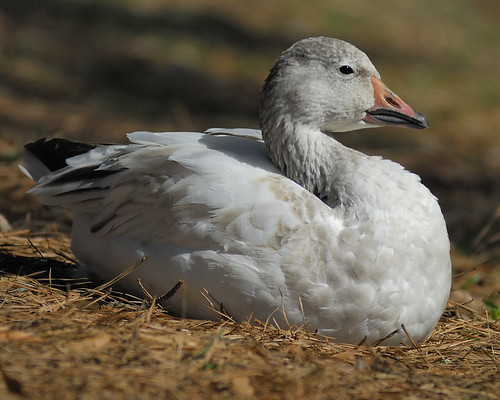tags: Snow Goose, Chen caerulescens, birds, mystery bird, bird ID quiz
[Mystery bird] Juvenile Snow Goose, Chen caerulescens, photographed at Hermann Park, Houston, Texas. [I will identify this bird for you tomorrow]
Image: Joseph Kennedy, 2 February 2008 [larger view].
Nikon D200, Kowa 883 telescope TSN-PZ camera eyepiece 1/2500s f/8.0 at 1000.0mm iso400.
Rick Wright, Managing Director of WINGS Birding Tours Worldwide, writes:
Another white waterfowl. This is a biggish bird, heavy-headed and heavy-billed, and we should probably rule out Graylag before deciding that it is a North American native. The bill of Graylag Goose is even heavier, decidedly orange, and lacks the open tomia that form the "grin patch" so conspicuous on this bird. The neck of our quiz subject is also long and rather slender, and the contrast between the black primaries and the whitish remainder of the plumage tells us that we are looking at a white Chen. The length of the neck, the blocky head, and the long bill with big black "lips" points to a Snow Goose, while the dusky appearance of the plumage tells us we're dealing with a juvenile.
Just as in the case of the recent Ross's-type Goose, however, I would warn that there is strictly speaking no way to be certain that this bird doesn't have, somewhere deep in its past, some Ross's genes. Without a blender and a slip of litmus paper (or however the DNA guys do it), we just can't tell in the field. Birders could make a modest contribution to the question by scrutinizing Snow Geese with the same care they apply in watching apparent Ross's Geese -- while the smaller taxon is still enough of a novelty to draw attention over much of its new winter range, Snow Geese, as the "default" species, are almost never inspected with the same acribie. Next time you get a chance, look hard at your Snows, and who knows what you'll know?


snow goose, probably a juvenile or possibly just dirty from feeding
Juvenile white Snow Goose, probably Lesser, given the proportions of the beak. Dunno how it managed to get quite that scruffy, though....
It's definitely not some sort of tern or sandpiper... =D
I'm at a disadvantage since I have no familiarity with North American birds, but I would say that this is a Snow Goose. It's not a Ross's Goose because of the black margins to its bill (at least, that's what Wikipedia tells me).
Off Topic, but I thought you would be interested:
http://www.nytimes.com/2008/10/07/science/07bird.html?_r=1&ref=science
Snow Goose, definitely.
There's the grinning patch of the Snow Goose.
It's Snow White, obviously.
I agree with Hilary particularly the comment about it probably being a Lesser. It's probably scruffy looking from having vigorously defended its lineage; someone called it a hybrid.
I'm always happy to learn from those more erudite and experienced: how do you distinguish Greater and Lesser Snow Geese in the field?
Thanks!
I'm always happy to learn from those more erudite and experienced: how do you distinguish Greater and Lesser Snow Geese in the field?
Thanks!
As to how to pick out Lesser in the field, I haven't the faintest. I was just looking at the proportions in Sibley's cheat sheet, p. 79 of the big book.
As to how to pick out Lesser in the field, I haven't the faintest. I was just looking at the proportions in Sibley's cheat sheet, p. 79 of the big book.
As to how to pick out Lesser in the field, I haven't the faintest. I was just looking at the proportions in Sibley's cheat sheet, p. 79 of the big book.